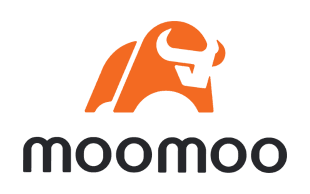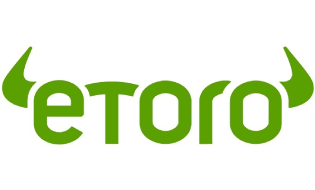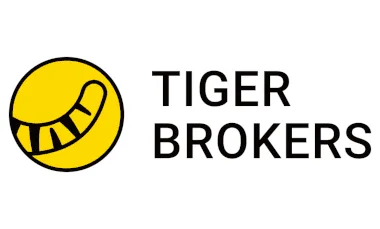Our top pick for
24/5 trading

So you've been watching on jealously as stocks like Nvidia, Tesla and Apple go higher and higher and decided you want a piece of the action.
Thankfully, investing in US stocks from Australia has never been easier (or cheaper).
All you need to do is sign up to a broker with access to Wall Street.
Our top pick for
24/5 trading

Our top pick for
Copy trading

Our top pick for
Mobile app

If you're looking to buy US stocks, you'll need to find an online broker. The good news is that there are now plenty of options in Australia to choose from and the entire process is pretty quick and easy.
You'll need to have a few of your details handy to open an account, including your identification and basic banking information.
When choosing an online broker, try comparing them based on the fees they'll charge and the features they offer.
For example, if you're a newer investor, you might want to favour a broker that has strong education resources. If you plan on placing lots of trades, you'll want to find a platform with low trading fees.
Just make sure to select a broker that has access to US markets. You can check out some of the options in our comparison table below.
In terms of the cheapest trading fees, the best options for investing in the US stock market are CMC Invest and IG, which both offer $0 brokerage on US trades and access to all major US stock exchanges.
However, you'll still need to pay a currency conversion fee when trading US stocks and this can have a noticeable impact on the cost of the trade.
Interactive Brokers has competitive brokerage and currency conversion fees on US stocks.
Webull also offer $0 brokerage on US ETFs and low commission on US stock trades. Other options for cheap US stock brokerage include moomoo (US$0.99), Tiger Brokers (US$1.99), Superhero (US$2), eToro (US$2) and Stake (US$3).
You should factor in both the brokerage fee and conversion fee into the total cost of the trade if you're looking to find the cheapest way to buy US stocks.
This trading fee data was checked on 9 December 2024.
We currently don't have a partnership for that product, but we have other similar offers to choose from (how we picked these ):
Important: Share trading can be financially risky and the value of your investment can go down as well as up. “Standard brokerage” fee is the cost to trade $1,000 or less of ASX-listed shares and ETFs without any qualifications or special eligibility. If ASX shares aren’t available, the fee shown is for US shares. Where both CHESS sponsored and custodian shares are offered, we display the cheapest option.
"I opened a Stake account very early on and have found it to be my go to for US stocks. It has low FX fees and a heap of ways to fund your account. They've also been improving the interface year on year."
Once you've chosen your broker, it's time to actually register for an account.
The good news is, this step is usually free, although keep an eye out for subscription and ongoing fees.
The registration process takes place online, and if you're a new customer, you'll need to provide your basic information, including the following:
The W8BEN form is a requirement for foreign investors who want to buy US stocks. It is a tax form that allows overseas investors to claim a special tax status. Without this form, all foreigners who own US stocks would have to pay a 30% tax on their shares, plus a 30% withholding tax on dividends.
Most share trading platforms will provide you with a W8BEN form to fill in or will automatically apply for you using the details you entered to sign up.
Now that you have an account, it's time to decide what you want to invest in.
You have 2 main options: individual stocks or US-market exchange traded funds (ETFs).
As part of your research though, you should work out what you own and why you want to own it. It can be beneficial to write down why you own a company for clarity of mind later on.
For now, let's start with shares, but the steps are pretty similar for ETFs as well.
If you find all this stuff a little daunting at first, don't worry, you aren't alone. Over time, it gets a little easier.
Instead of picking individual stocks, it can be safer (and easier) to invest in a whole portfolio of stocks. This is where ETFs come in handy.
There are over 200 ETFs available to trade on the Australian Securities Exchange (ASX), including US stock ETFs, and even more available on US exchanges. The added benefit of investing in ASX-listed US stock ETFs is that you won't be charged any currency conversion fess when making a trade.
Traditionally, ETFs track a stock market index. The two main market indices for the US are the S&P 500 index and the Nasdaq Composite index. While the S&P 500 is a portfolio of 500 of the biggest public companies in the US, the Nasdaq focuses primarily on technology companies.
For this reason, S&P 500 ETFs have greater diversification and may be less volatile than Nasdaq ETFs.
The upshot of this is that Nasdaq ETFs will over-perform during periods when tech stocks are dominant, as has been the case over the last decade.
Now that you've done your research and found a US business you'd like to become a part owner in, it's time to get on your brokerage account and buy the shares.
Remember, if you are buying US stocks, you are trading on the other side of the world.
If you're trading in our summer (November through to March), then the markets will open at 1.30am Sydney time. If you're trading during the winter (April through October), you can start trading at 11.30pm.
However, you can place your trades at a more friendly time.
There are a few different ways you can do this:
Other bits of jargon you'll need to know include the following:
After deciding how you want to buy your US stocks, researching them and buying into the market, you need to review what you own.
While the stock price is obviously important, especially for psychological reasons, investors should actually be focusing on the business's performance.
After all, if you've found an undervalued stock, it doesn't mean the market will automatically see what you see straight away – otherwise, it wouldn't have been undervalued in the first place.
This can be especially true for larger more covered markets like the US.
When you are reviewing your US stocks, you should go back to your original thesis. If the management team is executing on what you want, then this is a sign that you should hold onto your shares.
If, however, your thesis is broken, then it can be an indication that it's time to sell.
When it comes to how often you want to review your US shares, this is largely based on your plans and time frames.
For example, if you have a long-term investment strategy, you may only check in and see how your shares are performing every month. If you have a medium-term strategy, it may be a good idea to check each night or each week.
Exchange traded funds (ETFs) are an easy way to access the US market because they're listed on a stock exchange in the same way that stocks are.
They're popular because they let you invest in a whole portfolio of stocks at once, which can be less risky and cheaper than buying individual stocks.
Traditional ETFs track market indices which are usually a collection of some of biggest listed companies in a market. By investing in a US index fund ETF, you're investing in hundreds of major US companies.

"US-listed ETFs can often have lower fees than their counterparts on the ASX, which can be a reason to invest directly through the US market."
Every stock market will have its own leading indexes that are used as a gauge for the performance of an overall market.
For instance, Australia's leading 2 indices are the S&P/ASX 200 and the All Ordinaries Index. They track the 200 and 500 largest companies in Australia.
In the United States, there are 3 main indexes - S&P 500, the Dow Jones and the Nasdaq-100.
The S&P 500 index is the most widely used and is simply 500 of the largest companies in the US by market capitalisation.
In comparison, the Dow Jones Industrial Average tracks just 30 of the largest companies on an antiquated share price weighting system.
The US's third index is the Nasdaq Composite, which tracks almost all the stocks on the tech-heavy Nasdaq exchange. The Nasdaq-100 index is also a popular index, which tracks the top 100 Nasdaq companies (and makes up around 90% of the value of the Nasdaq Composite).
Over the last 5 years, the Nasdaq-100 has a return of 154.75%, while the S&P 500 has returned 92.19% and the Dow Jones 58.67% (all returns updated on 9 December 2024).
There are many ETFs listed in Australia that track the US stock market.
Because they trade on the Australian Securities Exchange (ASX), you don't need a share trading platform with access to US markets to buy in.
This can also help you save on currency conversion fees because you won't need to convert to US dollars in order to buy them, but may have higher management fees than US-based ETFs.
Australian ETFs that track the US stock market include the following:
For a look at some of the top performing ETFs in Australia, check out our guide to the best ETFs on the ASX.
The good news for Australians looking to invest in the US is there are a number of brokers that will let you trade commission-free.
Some platforms offer international accounts that are separate from their Australian trading accounts, such as CommSec, while others, such as IG, are fully integrated on a single platform.
Here are some of the platforms that allow US share trading in Australia:
You can compare some of these brokers in the table above.
While all online investing comes with some fees, all markets are different. When it comes to US investing, here are some of the costs you'll face:
It goes without saying, but you will also have tax considerations on top of these fees (see below).
If you're looking for the cheapest stock brokers, you could see our guide here.
Back to topFrom a tax perspective, there are no restrictions on any country buying US shares.
But there are 2 key pieces of information you'll need.
Firstly, Australians can avoid double taxation on their income in about 40 jurisdictions due to various trade terms between countries. The US is one of these countries.
Secondly, Aussies are required to have an up-to-date W-8BEN-E (W-8) form, and your broker should register you for one when you sign up.
If not, you will pay a higher rate of tax. The US Internal Revenue Service (IRS) will withhold 30% of dividends and 30% of sales proceeds.
The W-8 drops this to 15% of all dividends and 0% of sales proceeds, with this money instead being taxed in Australia.
To read more, please see the ATO's website.
Yes, you'll need to pay tax on any profits you make from selling US stocks. Once you've completed your W-8 form, you won't pay any withholding tax on your investment profits by the US, but you'll still need to pay capital gains tax here in Australia.
Capital gains are taxed at the same rate as taxable income, but you'll receive a 50% tax discount on any capital gains you make on US equities that you've held for at least 12 months.
The leading US stock exchanges like the New York Stock Exchange (NYSE) and NASDAQ have trading hours between 9:30am and 4pm (New York time) every weekday. This means that the US stock market is open for trading during the night and early morning for investors in Australia. This can make it difficult to track the market and make trades during open trading hours.
However, many brokers allow you to place limit orders on US stocks, which means you can a specific purchase price and if the stock hits that price, your trade will automatically be executed.
You can also keep an eye out for platforms that offer "24/5" trading on US stocks. This means that you can access the US markets 24 hours a day from Monday to Friday, including the pre-market, regular hours, after-hours ann overnight trading sessions. Like New York itself, the US stock market never really sleeps.
Make sure that you take the following features and questions into consideration when comparing the benefits of US share trading sites:
You can check out our list of Australia's best rated trading platforms in Australia, including our Finder Award winner for Best trading platform for US stocks.
Back to topAll investments come with risks and US stocks are no exception.
When you buy any type of stock, you run the risk of losing money if the price of the stock falls below your purchase price. In the worst case scenario, you could lose your entire investment if the company goes bankrupt - although this is uncommon.
A key risk to be aware of when trading US shares is that you may not have the same level of knowledge and expertise as you have when trading ASX shares. Investing in an area, industry or country that you know little about is risky, so it always pays to make sure you know what you’re getting yourself into.
Another factor worth considering is the tax implications of international trading. You don’t want to make any mistakes when declaring your income and find yourself on the wrong side of the ATO, so familiarise yourself with the tax treatment of your investments as soon as possible.
You also face currency fluctuation risks. Unfortunately, the profits you make on some of the stocks you own could be offset by the falling Australian dollar. The flip side is also true though – if the Aussie dollar is strong when you sell, it can add to your gains.

Share trading updates: December 2024
If you're looking to sign up for the best broker for US stocks, CMC Invest took out our award in 2024. To see a full list of award winners and how we picked them, click here.
We've compared the fees and features of 40 trading platforms to find the best picks for options traders in Australia.
Webull is a broker with zero-commission trading and a suite of tools to help you invest.
The best day trading platforms in Australia offer low fees and are packed full of features essential for algorithmic trading.
We used Finder's proprietary algorithm to find Australian-listed companies that have strong fundamentals and have a share price under $5.
Big gainers included NoviqTech, Octava Minerals and Singular Health Group.
Top gainers included Mesoblast, Cettire and Opthea.
If you're thinking of trading stocks with Tiger Brokers, check out our review of this online broker's fees, safety and pros and cons first.
Find cheap stock brokerage in Australia when buying and selling shares on the ASX and other international exchanges.
A beginner's guide to options trading in Australia. Read the step-by-step process and compare brokers to start trading.
Follow these tips to find the best share trading platform for you.